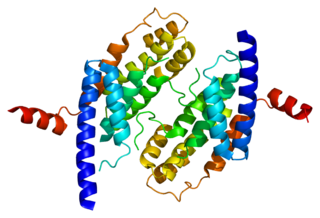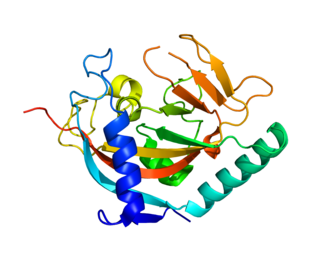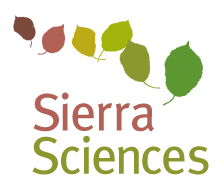PIN2/TERF1-interacting telomerase inhibitor 1, also known as PINX1, is a human gene. [4] PINX1 is also known as PIN2 interacting protein 1. [5] PINX1 is a telomerase inhibitor and a possible tumor suppressor.
PIN2/TERF1-interacting telomerase inhibitor 1, also known as PINX1, is a human gene. [4] PINX1 is also known as PIN2 interacting protein 1. [5] PINX1 is a telomerase inhibitor and a possible tumor suppressor.
PINX1 has been shown to interact with MCRS1, [6] TERF1 [7] and telomerase reverse transcriptase. [7]
There are two known variants of PINX1. The second variant “lacks an exon in the 3’ coding region which results in a frameshift compared to variant 1. The encoded isoform is shorter and has a distinct C-terminus compared to isoform 1.” [5] There are three PINX1 cDNA clones. The longest one encodes a 328 amino acid 45kDa protein which contains an N-terminal Gly-rich patch and a C-terminal TID domain (telomerase inhibitory domain). The TRF1 binding domain is in the C-terminal 75 amino acids of PINX1. Mouse PINX1 is 74% identical to human PINX1. In other eukaryotes, including yeast, there is an overall 50% similarity to human PINX1. [7] [8]
Over-expression of PINX1 results in decreased telomerase activity, telomere shortening, and induction of crisis. Reduction of PINX1 leads to an increase in telomerase activity and elongation of telomeres. PINX1 differs from other proteins that regulate telomere length in that it acts on telomerase while other proteins adjust telomere length without affecting telomerase activity. [7]
The PINX1 budding yeast orthologue Gnop1 inhibits telomerase by isolating the uncomplexed TERT protein so that it cannot associate with the telomerase template RNA, which prevents telomerase from being assembled. However, in humans, PINX1 impedes already assembled telomerase. PINX1 binds to N-terminus of hTERT and binds to hTR in the presence of hTERT. PINX1 binding to hTR “is correlated to the repressive function of PINX1 on telomerase, implying that the mode of enzyme telomerase inhibition by PINX1 may involve an associated with hTR....The effect of hPINX1 on telomerase appears to be exclusive of the G-patch region and is mediated instead by the C terminus of the protein. This suggests that hPINX1 may have functionally separable cellular effects in which the N terminus is involved in RNA processing via the G-patch, and the C terminus is involved in telomere dynamics.” [9] It is suggested that “PINX1 represses telomerase activity in vivo by binding to the assembled hTERT-hTR complex.” [9]
The TID domain of PINX1 is likely what binds to hTERT. In cells, full-length PINX1 is not as strong as just the TID domain at inhibiting telomerase. This may be due to full-length PINX1 being subject to “endogenous regulation such as posttranslational modifications to reduce its inhibitory activity.” [7] Or it may be due to a reduction of the TID domain to bind and inhibit telomerase as a result of proteins interacting with PINX1, such as PIN2/TRF1 which colocalizes PINX1 in cells. [7]
There are two types of PINX1: nuclear PINX1 which is associates with telomeres and CAC repeats and nucleolar PINX1 does not bind directly to the telomeres, but instead interacts with TRF1. Nucleolar hPINX1 mediates the movement of hTERT and TRF1 to the nucleolus. Over-expression of nucleolar hPINX1 leads to increased TRF1 in the nucleolus and binding to telomeres. However, this accumulation in the nucleolus was not found in ALT (alternative lengthening of telomeres) cells indicating that PINX1 function is telomerase dependent. [10] [11]
hPINX1 is found more in the nucleoplasm during the S phase which is also when telomerase is released into the nucleoplasm indicating that hPINX1 may inhibit telomerase during the S phase. [10]
PINX1 is located at 8p23. Heterozygosity of this area is frequently lost in tumors including liver, prostate, prostate, colorectal, lung, and head and neck. Most PINX1 mutant tumors are carcinomas. PINX1 expression is significantly reduced in these tumors. This significance was shown with HT1080 cells, which increased tumorigenicity with decreased PINX1 expression. Over-expression of PINX1 in HT1080 cells did not allow them to form tumors in mice. Therefore, PINX1 may be a tumor suppressor. [7] [12]
PINX1 expression is a predictor of cervical squamous cell carcinoma (CSCC) cells response to cisplatin/paclitaxel chemotherapy. High levels of PINX1 correlated to response. But the levels of PINX1 were only associated with cytotoxicity of paclitaxel. Reduced levels of PINX1 led to increased paclitaxel cytotoxicity. “The ability of PINX1 to stabilize the tension between sister kinetochores and maintain the spindle assembly checkpoint was the main reason CSCC cells undergo apoptosis when treated with paclitaxel.” [13]
Chemoradiotherapy is a standard treatment for advanced esophageal squamous cell carcinoma (ESCC). Reduced PINX1 expression did not affect ESCC cells response to 5-fluorouracil and cisplatin, but did increase efficacy of radiation therapy. High levels of PINX1 led to reduced cell death due to radiation. “PINX1 resistance to radiotherapy (RT) was attributed to PINX1 maintaining telomere stability, reducing ESCC cell death by RT-induced mitosis catastrophe.” [14] High levels of PINX1 is a predictor of short disease-specific survival. [14]
PINX1 levels were found to be reduced in urothelial carcinoma of the bladder (UCB) compared to normal urothelial bladder epithelium. “PINX1 levels were inversely correlated with tumor multiplicity, advanced N classification, high proliferation index, and poor survival.” [15] Over-expression of PINX1 reduced UCB cell proliferation and G1/S phase arrest. Knockdown PINX1 led to increased cell proliferation and accelerated G1/S transition. [15]
PinX1 in other cancers:

Telomerase, also called terminal transferase, is a ribonucleoprotein that adds a species-dependent telomere repeat sequence to the 3' end of telomeres. A telomere is a region of repetitive sequences at each end of the chromosomes of most eukaryotes. Telomeres protect the end of the chromosome from DNA damage or from fusion with neighbouring chromosomes. The fruit fly Drosophila melanogaster lacks telomerase, but instead uses retrotransposons to maintain telomeres.

Telomerase reverse transcriptase is a catalytic subunit of the enzyme telomerase, which, together with the telomerase RNA component (TERC), comprises the most important unit of the telomerase complex.

Telomeric repeat-binding factor 2 is a protein that is present at telomeres throughout the cell cycle. It is also known as TERF2, TRF2, and TRBF2, and is encoded in humans by the TERF2 gene. It is a component of the shelterin nucleoprotein complex and a second negative regulator of telomere length, playing a key role in the protective activity of telomeres. It was first reported in 1997 in the lab of Titia de Lange, where a DNA sequence similar, but not identical, to TERF1 was discovered, with respect to the Myb-domain. De Lange isolated the new Myb-containing protein sequence and called it TERF2.

Homeobox protein Nkx-3.1, also known as NKX3-1, NKX3, BAPX2, NKX3A and NKX3.1 is a protein that in humans is encoded by the NKX3-1 gene located on chromosome 8p. NKX3-1 is a prostatic tumor suppressor gene.

Telomeric repeat-binding factor 1 is a protein that in humans is encoded by the TERF1 gene.

Telomerase RNA component, also known as TR, TER or TERC, is an ncRNA found in eukaryotes that is a component of telomerase, the enzyme used to extend telomeres. TERC serves as a template for telomere replication by telomerase. Telomerase RNAs differ greatly in sequence and structure between vertebrates, ciliates and yeasts, but they share a 5' pseudoknot structure close to the template sequence. The vertebrate telomerase RNAs have a 3' H/ACA snoRNA-like domain.

AT-rich interactive domain-containing protein 1A is a protein that in humans is encoded by the ARID1A gene.

Protection of telomeres protein 1 is a protein that in humans is encoded by the POT1 gene.

Microtubule-associated protein RP/EB family member 1 is a protein that in humans is encoded by the MAPRE1 gene.

Tankyrase, also known as tankyrase 1, is an enzyme that in humans is encoded by the TNKS gene. It inhibits the binding of TERF1 to telomeric DNA. Tankyrase attracts substantial interest in cancer research through its interaction with AXIN1 and AXIN2, which are negative regulators of pro-oncogenic β-catenin signaling. Importantly, activity in the β-catenin destruction complex can be increased by tankyrase inhibitors and thus such inhibitors are a potential therapeutic option to reduce the growth of β-catenin-dependent cancers.

Adrenocortical dysplasia protein homolog is a protein that in humans is encoded by the ACD gene.

Telomerase protein component 1 is an enzyme that in humans is encoded by the TEP1 gene.

Tankyrase-2 is an enzyme that in humans is encoded by the TNKS2 gene.

Sierra Sciences, LLC is a biotechnology company founded by William H. Andrews, former director of molecular biology at Geron Corporation. Andrews founded Sierra Sciences in 1999 in Reno, Nevada with the goal of preventing and/or reversing cellular senescence, and ultimately curing diseases associated with human aging, including the aging process itself.
William Henry Andrews is an American molecular biologist and gerontologist whose career is centered on searching for a cure for human aging. Andrews is the founder and president of the biotechnology company Sierra Sciences. In the 1990s, he led the team at Geron Corporation that was the first to successfully identify the genes for human enzyme telomerase. This enzyme is responsible for preventing telomeres from shortening in human primordial germ cells.
Shelterin is a protein complex known to protect telomeres in many eukaryotes from DNA repair mechanisms, as well as to regulate telomerase activity. In mammals and other vertebrates, telomeric DNA consists of repeating double-stranded 5'-TTAGGG-3' (G-strand) sequences along with the 3'-AATCCC-5' (C-strand) complement, ending with a 50-400 nucleotide 3' (G-strand) overhang. Much of the final double-stranded portion of the telomere forms a T-loop (Telomere-loop) that is invaded by the 3' (G-strand) overhang to form a small D-loop (Displacement-loop).

Titia de Lange is the Director of the Anderson Center for Cancer Research, the Leon Hess professor and the head of Laboratory Cell Biology and Genetics at Rockefeller University.

GTP-binding protein Di-Ras3 (DIRAS3) also known as aplysia ras homology member I (ARHI) is a protein that in humans is encoded by the DIRAS3 gene.

María Antonia Blasco Marhuenda, known as María Blasco, is a Spanish molecular biologist. She is the current director of the Spanish National Cancer Research Centre.

WRAP53 is a gene implicated in cancer development. The name was coined in 2009 to describe the dual role of this gene, encoding both an antisense RNA that regulates the p53 tumor suppressor and a protein involved in DNA repair, telomere elongation and maintenance of nuclear organelles Cajal bodies.